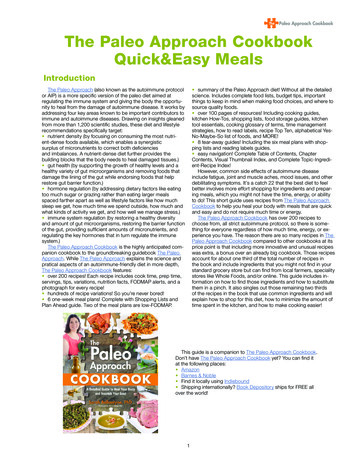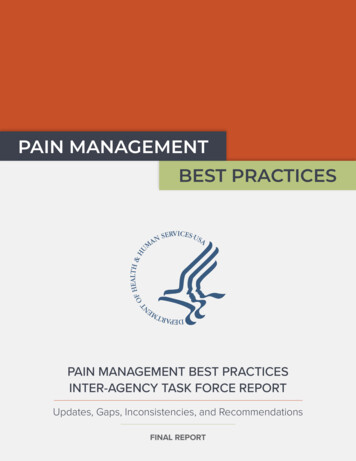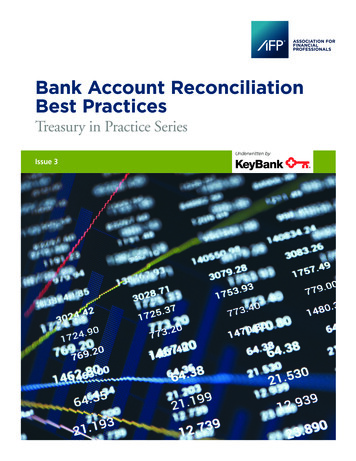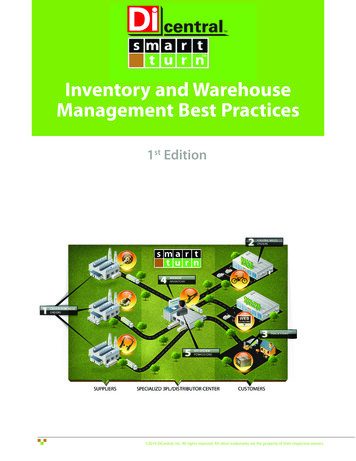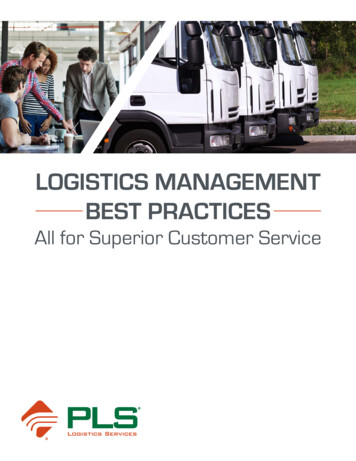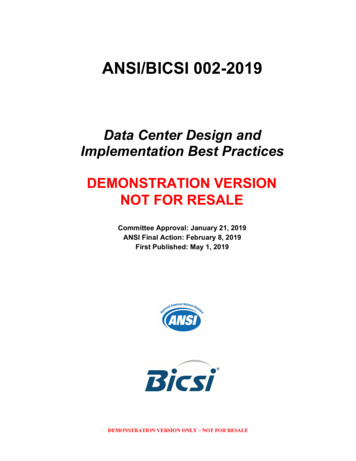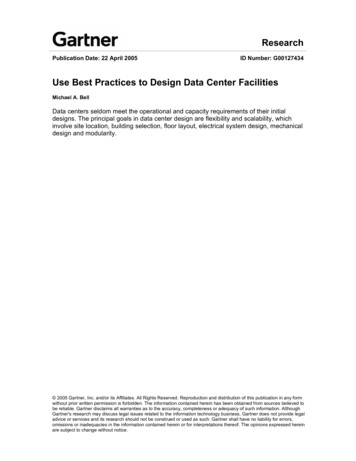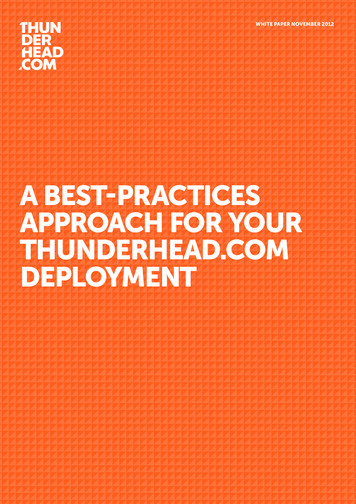
Transcription
WHITE PAPER NOVEMBER 2012A BEST-PRACTICESAPPROACH FOR YOURTHUNDERHEAD.COMDEPLOYMENT
WHITE PAPER A BEST-PRACTICES APPROACH FOR YOURTHUNDERHEAD.COM DEPLOYMENT01INTRODUCTION“To turn initiatives intoDefining and following best practices aresustainable programsimportant steps to getting the most value fromthat continuouslyyour Thunderhead.com implementation.improve and transformIt’s been shown that companies whoOne approach that’s proven successfuldevelop standards and governance asin many organizations is creating anprocesses, businessbest practices for their customer exenterprise center of excellence (COE)process professionalsperience solutions achieve the followingfor Thunderhead.com initiatives.must establish centers of goals; they:In this paper we’ll talk first about bestexcellence (COEs) as Increase the effectiveness of theirpractices with respect to yoursolution especially related toThunderhead.com implementation andquickly as the organizationenterprise applications – whetherthen about the benefits of creating acan support them.”multi-channel NOWThunderhead.com COE.Thunderhead.– Alexander Peters fromForrester Researchimplementations or online SaaSimplementations Significantly reduce costs associatedwith disparate systems andredundancy Improve the overall customerexperienceBut how do you ensure that thestandards and governance proceduresyou’ve developed are implemented,maintained, and deployed throughoutthe enterprise?2com software is designed to enablelarge organizations to leverage itscomponents across multiple channels,business areas, and ultimately customerexperience strategies. At the same time,we all recognize that a unified approachto customer communications is requiredin order to ensure a consistent customerexperience. For these reasons, developinga center of excellence for yourThunderhead.com implementations isan appropriate strategy.
025 BEST PRACTICES FOR CUSTOMERCOMMUNICATIONS WITHTHUNDERHEAD.COMThunderhead.com provides the toolsand capabilities to help you drivecustomer communications and designand deliver a great customerexperience. Working with ourcustomers, we’ve identified five areas ofbest practices that will help you ensuresuccess in your Thunderhead.comimplementation: data models, style andbranding, communication templates,infrastructure and operations, andbusiness process.Data models: It’s important to have asolid data model for a successfulimplementation. However, it’s alsoimportant to look at how the datamodels for a specific project mightapply beyond that project, includinglonger-term goals. You should thereforeconsider how data will be used incommunications across the enterprise,both to ensure consistency and to allowdata from transactional events andrealtime conversations to be used inmanaging the customer journey.Style and branding: Developing abest-practices style library inThunderhead.com for your overallbrand communications can help youensure that new documents andprojects adhere to your brandguidelines. Styles can be defined for allchannels; web, email, SMS, and printand can include commonly usedobjects such as logos, signatures,address information, letterhead, andlegal language, as well as support theapplication of your brand tone of voice,and so on. You can then establishgovernance to make sure that deviationsfrom the style guide and additions to itare managed appropriately.Communication templates: In thisarea, it’s important to consider yourlong-term design goals in addition tothe template designs you’re using forcurrent projects. A good best practice isto establish a subject matter expert(SME) for template design. The SME canthen lead workshops and trainingprograms for anyone else in theenterprise who will be using thecommunication templates. For manyorganizations, the ultimate goal is toturn maintenance and control oftemplates over to business usersas much as possible.Infrastructure and operations:Cross-enterprise use of Thunderhead.com infrastructure, APIs, andmultichannel enablement is one wayyou can realize cost savings with yourThunderhead.com implementation.Developing a COE may help to ensurethat all functional units have theexpertise they need to take advantageof the capabilities and efficiencies inThunderhead.com.Business process: Understanding anddocumenting business processes andrequirements – appropriate sizing,implementation planning, projectmanagement, and testing procedures– is important for businessimprovement and transformation. Thisis where the Professional Services teamat Thunderhead.com can help. We’vedeveloped many different projects formany different companies, and thatexperience enables us to work with yourteam or COEs to share knowledge andbest practices about how to transformbusiness processes throughout theenterprise.3
WHITE PAPER A BEST-PRACTICES APPROACH FOR YOURTHUNDERHEAD.COM DEPLOYMENT03CONSTRUCTING A COE TEAM FORYOUR THUNDERHEAD.COMIMPLEMENTATIONAs we alluded to above, it’s one thing todevelop a set of best practices for theorganization to follow. It’s quite anotherthing to make sure those best practicesare followed, maintained, and, whereappropriate, revised or discarded.Centers of excellence can help yourorganization achieve those goals.For example, companies that committhemselves to delivering a greatcustomer experience know that theymust not only develop best practicesaround customer experience but makesure that every person embraces themand every process is aligned to it.Centers of excellence can be used quiteeffectively to define customerexperience strategies, set standards, andpromote best practices.Technically speaking, centers ofexcellence are usually small, crossfunctional teams or groups thatestablish and maintain a set ofprocedures to ensure that the largerorganization can meet its strategicgoals. Connie Moore from CIOMagazine suggests that to be mosteffective, companies should createCOEs that are “small and nimble, andreplicate them throughout theorganization.”1 When building a COEteam, you will likely want to fill anumber of roles. This team must notonly understand best practices for aThunderhead.com implementation,they will also be responsible forunderstanding your organization’s visionwith respect to customercommunications (and customerexperience management).4Typical areas of responsibility we’veseen in successful COEs include thefollowing: New project sizing and riskassessments Data model and integration bestpractices Template best practices and brandgovernance Multichannel standards (withresponsibility for output and printvendor management) Quality assurance guidelinesAlthough it’s common for the COE itselfto be managed within IT, members ofthe COE team often come fromdifferent areas within the organization,including key business owners andstakeholders in marketing, compliance,support, and customer service. Thisapproach can ensure that the COE isresponsive to the business while helpingto drive standards and governance.Engaging all departments is especiallyimportant when the purpose of the COEis to implement a broad strategic goal,such as delivering a consistent, best-inclass customer experience
04LEVERAGING YOUR INVESTMENT TODEVELOP A GREAT CUSTOMEREXPERIENCEAs some enterprises are discovering,COEs are not merely helpful fordeveloping and maintaining standards,these small agile teams can actuallytransform the larger organization.According to Alexander Peters fromForrester Research,To turn initiatives into sustainableprograms that continuously improveand transform processes, businessprocess professionals must establishcenters of excellence (COEs) asquickly as the organization cansupport them.Continuous improvement is certainly aworthy goal, but sometimes wholesaletransformation is needed. One areawhere that is often true today is the wayin which many organizations handlecustomer communications andultimately the customer experience.Unlike Apple (a company that obsessesabout customer experience in everydetail, at every touch point, in everycommunication), many businessestoday offer their customers afragmented or disjointed experience.The web experience is disconnectedfrom the retail experience, onlinesupport is different from phone support,email and print communications are notrelated, and so on.In its report, “The Customer ExperienceIndex, 2012,” Forrester found thatcustomers rated only 37% of thecompanies they do business with asgood or excellent. Nearly two-thirdsreceived a rating of OK, poor, or verypoor. Customers described experiencessuch as “going to a store, only to be sentto a website, then to interactive chatand a phone call, to end up with a paperform to sign.” Customers, says Forrester,“are tired of it.”This fragmentation is why manyorganizations have turned to customerexperience management (CEM). Theyrecognize that customer experience isthe responsibility not solely of themarketing department, but of the entireenterprise. They also recognize theimportant role that technology – andthus, the IT department – will play inensuring that every touch point with thecustomer is considered and integrated.Which brings us back to centers ofexcellence and Thunderhead.com.Thunderhead.com offers enterprisesolutions that improve the waybusinesses engage with their customers.These solutions help organizationsmaintain consistent conversations andcommunications across all channels,from print to digital (web, mobile, andsocial) to the call center. Creating a COEaround your Thunderhead.comimplementation then allows you to steerthe entire organization toward one goal:creating a stellar experience for yourcustomers.WE’RE HERE TO HELPSetting up a center ofexcellence may be a newexperience for some ofour customers, and we’rehappy to help with that.Our team at Thunderhead.com is available toconduct a best practicesworkshop with yourorganization and thenwork with you to establisha COE tailored to yourbusiness. Please contactus to learn more:customersuccess @thunderhead.comImagine that you had this kind ofpervasive dedication to your customers’needs across your enterprise. With thesupport of a customer-focused COEyou could continuously improve theexperience in every conversation. Youcould deliver exactly what consumerswant, every time. Companies thatdeliver this superior customerexperience outperform the status quoto drive customer loyalty, competitiveadvantage, improved brand health andincreased revenue. Aligning anenterprise around creating aphenomenal customer experience is thekind of transformation that COEs aredesigned to enable.5
WHITE PAPER A BEST-PRACTICES APPROACH FOR YOURTHUNDERHEAD.COM DEPLOYMENTAPPENDIX 1. BEST PRACTICESEXAMPLESOne of the hallmarks of Thunderhead.comis the ability to reuse and repurpose asmuch content as possible. Benefits ofreuse include:PROJECT 1TEMPLATE ATEMPLATE BSTYLESETLAYOUT X Greater consistency acrosscommunicationsSHARED CONTENT One central location for updates, sothat one change will update allrelated communication.SHARED CONTENTBUSINESS OBJECTTEMPLATE CLAYOUT YSHARED CONTENT Ability to manage and view theimpact of any change made tocontent that is common betweencommunicationsIn order to maximize the benefit ofshared content, Thunderhead.commakes the following recommendations.TEMPLATE DLAYOUT ZEach of the graphics in this sectionrepresents an example of the types ofbest practices typically governed by aCOE. Detailed guidelines documentedin a standards manual increaseeffectiveness while also reducing thelearning curve for new team members.PROJECT MANAGEMENT ANDRELEASE STRATEGIESBest Practices for project release cyclesshould include a design which modelsthe change cycle of the business. Abusiness change may for example requirechanges to five templates, four pieces ofshared content, and a layout. All of theseitems should be checked-out to theproject to allow the change to be made.The document templates will themselvespoint to released versions of otherresources – for example, a releasedstyleset or a released piece of sharedcontent. These do not need to be part6SHARED CONTENTof the project as they do not form partof this business change.In the Project A diagram example, someof the resources (with red ticks) are readyfor release before other resources in theproject. Best practices projectmanagement procedures should allowfor separate projects to be created toenable individual resources to be movedforward while leveraging Thunderhead.com’s built-in project management,approval workflow, and security.SHARED CONTENT, STYLESETS,AND LAYOUTSStandard stylesets and layouts to supportcompany branding are an importantarea for governance. We recommendpublishing a style guide for allThunderhead.com communication toensure adherence to the corporate brandas well as best practices for maintenance.Create shared content only when it isready to be sharedThunderhead.com’s shared contentconcept is a key factor in efficientdocument creation and reducing theoverall cost of maintenance. Sharedcontent should only be created when itis needed and when all of the data itemsthat need to be populated within it areavailable. While it is tempting to createshared content as soon as the staticcontent is ready, it is best to wait until itis populated with data items or assemblyrules, so that when it is imported into atemplate, the list of data items is createdautomatically. These data items can beset after the shared content is created,but it is much faster to do this after thedata and rules have been created.Here are some initial questions to answerto help facilitate a best practices reviewsession where Thunderhead.comProfessional Services will assist yourorganization with standards andgovernance leveraging a COE.
multiple stages of approval frommultiple groups and/or users), accordingto specifications.The approval workflow functionality inThunderhead.com’s Approve NOWfeatures: Multiple workflows per project Workflow design functionality thatenables sophisticated workflowrouting Parallel approval Group-based approval, in additionto approval by named individuals An Inbox showing all items awaitingapproval Collaborative annotationCreate inline shared content forcommon phrases which vary by abusiness ruleInline shared content is simply sharedcontent that uses the Inherit style toinherit its formatting from the parentdocument template. This can beextremely useful for applications wherethere are common words and phraseswhich must be controlled by businessrules. For example, a piece of inlineshared content might be created whichdisplays:For questions, call Customer Service– Telephone: 1-800-555-1234This could be utilized in many documents,providing for easy maintenance and asingle point of update.Use variable data by value, ratherthan by business object referencePassing variable data by value is thedefault and allows multiple documenttemplates to use the same sharedcontent. For example, an address blockmight have input data for AddressLine1through AddressLine6 and be used bymany document templates. If it were setup using business object referencesfrom within the shared content, it wouldonly be reusable in document templateswhich use exactly the same businessobject. If you pass the data asarguments, the shared content can beused with many different businessobjects.USERS, SECURITY, AND APPROVALLEVELSAll elements of the Thunderhead.complatform (modules, tasks, processes,screens, etc.) are securely controlledusing the principle of group-levelaccess. Each time a request is made touse a particular resource, the grouplevel access attributes are checkedagainst those marked on the resource.Defining standards is key for enterpriseimplementations. In addition, definingbest practices for simple and complexworkflows will ensure consistentefficiency within the organization.For example, workflows can be simple(taking entire projects directly from astate of development to a state of “readyfor release”) or complex (involving Target completion indicators, whichshow at a glance which items in aworkflow case require the mosturgent review Synchronization with externalthird-party workflow systems, viathe Thunderhead.com NOW API. Workflow cases are started from theProjects tab and are managedin Thunderhead.com Admin,via the Approval Workflows taband the Inbox.7
WHITE PAPER A BEST-PRACTICES APPROACH FOR YOURTHUNDERHEAD.COM DEPLOYMENTFORMS MANAGEMENT DESIGN ANDMETA DATABest practices for forms managementdesign are important especially whentaking full advantage of the complexselection criteria.You can use resource categories withAPI calls such as searchCMSByResourceCategory. You can also useresource categories from within BusinessContent Studio to retrieve shared contentor to retrieve enclosures.Typically attachments are selected bymultiple criteria such as line of business,state jurisdiction, effective date,commercial versus personal, etc.Standardizing the API calls for multiplebusiness areas to leverage becomes areusable asset best governed by a COE.However, consider the scenario whereyou have a large repository of forms thathave metadata within resource categoriesthat define perhaps 20 to 30 differentmetadata items. You could use anycombination of those metadata fields toretrieve specific sets of templates orenclosures.8RISK MANAGEMENT AND QUALITYASSURANCEA final example of the types of bestpractices recommended for centralgovernance are templates to helpproject managers follow provenmethodologies for risk managementand quality assurance. These templatesare built upon years of experienceimplementing complex projects inenterprise architecture environments.The templates include: Architecture sizing tools New project scope inventory andeffort assessments guidelines Unit, system, and integration testplan templates Project plans for high-quality, lowrisk, iterative development Risk management considerationsfor various project types includingmulti-channel batch, real-time, webportal integration, and highlysophisticated interactive documents.
APPENDIX 2. CUSTOMER SURVEY:GETTING STARTED WITH A BESTPRACTICES REVIEWHere are some initial questions to answer to help facilitate a best practices review session whereThunderhead.com Professional Services will assist your organization with standards and governanceleveraging a COE.BUSINESS OBJECTS AND XML SCHEMASRef#DetailsBOXML1How many business objects are being utilized in the Thunderhead.com environment?BOXML2What are the main factors for usage of multiple business objects?For example: feeding systems, applications, communication types.BOXML3Is there common data across all business objects?For example: an address class, etc.BOXML4Is all business object creation and maintenance facilitated through an XML schema(XSD file)?BOXML5Does the schema(s) reflect any common domain level data?For example: a recipient schema used to define a commonly used recipient class.BOXML6Is data organized into domain level classes and template specific classes?For example: data common to all communications in a set of classes and templatespecific data organized into further classes.BOXML7Is all data strongly typed?For example: monetary amounts defined as integer data types as opposed to strings.BOXML8Is the naming convention of data items “template author” friendly?For example: X101 Dt vs Policy Modification Date.BOXML9Are enumerations being used where appropriate?(Enumerations should be used, where possible, for all data items that have apredefined list of possible values. This mitigates risk of template authors incorrectlycoding assembly logic.)BOXML10In the case of large data models, are views being used?(Views can limit how much of the entire data model is visible to template authors, thusimproving usability.)9
WHITE PAPER A BEST-PRACTICES APPROACH FOR YOURTHUNDERHEAD.COM DEPLOYMENTDATA MANIPULATION AND AMALGAMATIONRef#DetailsDATMA1Are derived properties being populated with SQL queries out to external data sources?If so, approximately how many derived properties are being populated this way
Thunderhead.com provides the tools and capabilities to help you drive customer communications and design and deliver a great customer experience. Working with our customers, we’ve identified five areas of best practices that will help you ensure success in yo



